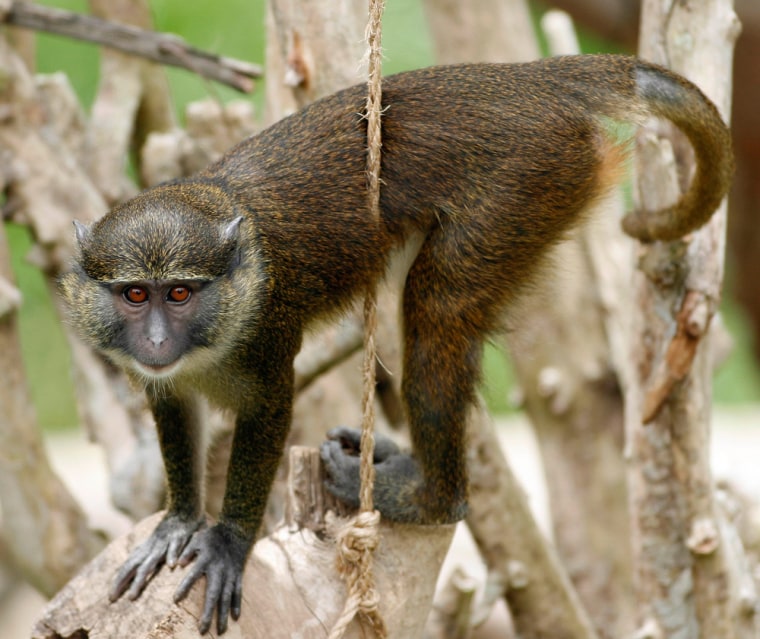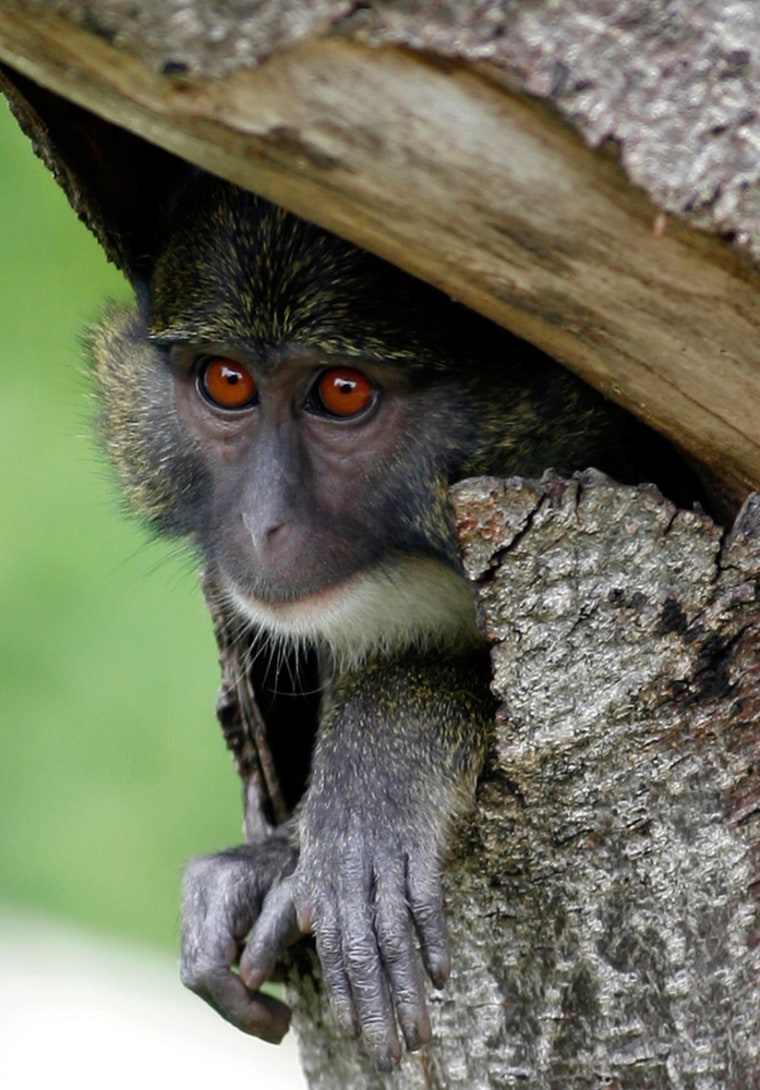The four new swamp monkeys at the San Diego Zoo have good reason to be a little wary. The last time they were in front of so many people, they were in a market in the Democratic Republic of Congo, destined for sale as exotic curiosities or else to be fattened up and eaten.
These four Allen's swamp monkeys, along with 30 other Congolese primates at five other zoos, will spend their lives in the United States to highlight the illegal trade in "bushmeat" - wildlife slaughtered to feed hungry families in poor countries - which is decimating populations of many species in Africa and parts of Asia.
"All these little monkeys were bushmeat orphans, their parents and troupes had been killed for bushmeat," explained Karen Killmar, the zoo's associate curator of mammals, who in an unusual move bought the monkeys from a middle man who had acquired them at a market and hoped to turn a profit by selling them as pets.
Jane Ballentine, a spokeswoman for the American Zoo and Aquarium Association, which helped coordinate the adoptions, called the acquisition "the right thing to do for the monkeys. This is a one-time-only thing, and we don't want to perpetuate the trade at all."
At the San Diego Zoo, the shy young monkeys, grayish brown and about the size of a cat, took turns exploring their new surroundings. The biggest of the group, a female, emerged from the cover of a small bush and briefly checked out a nearby tree before returning with a pounce to the safety of her cohorts.
Time and money
The monkeys, all less than 2 years old, debuted in early May in the zoo's Ituri Forest area, an enclosure named for the woods in Congo where the animals are from. The remaining monkeys, representing various species, went to zoos in the Phoenix area, Denver, Houston, San Antonio, Texas, and Tampa, Fla..
Signs to educate visitors about bushmeat will be displayed at each of the monkey enclosures.
It took 13 months and $400,000 to cut through the red tape and import the orphaned primates. The decision was a difficult one for the zoos, but they agreed it could raise awareness of the bushmeat problem.
The trade will take almost anything that moves for its flesh or skin, including snakes, big cats, primates and even hippopotamuses. Animals are sometimes used to create traditional medicines, particularly those killed in southeast Asia.
Hunters also target wildlife to feed an increasing international appetite for bushmeat, as expatriates from the region resettle around the globe. A Liberian woman was arrested in New York City this year on suspicion of importing smoked bushmeat, including monkey skulls, limbs and torsos.

"It's an enormous problem that is eliminating populations and whole species of wildlife across the continent," says Heather Eves, director of the Bushmeat Crisis Task Force in Washington, D.C., a nonprofit focusing on the illicit meat trade.
It's probably already too late for one primate species, known as Miss Waldron's red colobus monkey. The creature was declared extinct in 2000, though Eves says a few slaughtered monkeys have since shown up on the bushmeat market.
Danger of extinction
Further extinctions could follow. The impact of hunting on primate species is especially severe because monkeys and apes reproduce at a slow rate and produce fewer young, normally one baby at a time; killing even a few individuals can hurt a population.
Eves says she is often asked what bushmeat consumers would eat if they could not get protein from the jungle.
"Would people starve? They are starving now, so I would have to say yes," she says. "But we either figure a way to solve that problem now, or we solve that problem in 10, 15, or 20 years when all the wildlife is gone."
The United States found itself at a similar threshold when, as settlement expanded a century or more ago, many large wild animals were in danger of being wiped out. Hunting is now carefully regulated and herd sizes monitored.
Scientists working with the task force estimate as much as 1 million metric tons of wildlife are consumed annually in the central forest region of Africa and demand for wildlife meat is expected to keep growing by 2 percent to 4 percent a year.
The problem is at its worst in the Congo, where the government has passed several laws to protect wild animals, many of which are unique to the former Belgian colony, says Serge Tshamala, a spokesman at Congo's embassy in Washington, D.C.
"We have hired national guards and policemen," Tshamala says. "We are doing as much as we can to prevent this from happening."
'A unique opportunity'
Dire poverty complicates enforcement. Per capita annual income in Congo is around $100 per year, the U.S. State Department estimates; bushmeat hunters can earn 11 times as much, the Bushmeat Crisis Task Force says.
It was the lure of cash that ultimately saved the monkeys now in the United States. Killmar first learned of the animals last year when she received a call from a South African businessman who had bought them at a Congolese food market and hoped to make a buck reselling them as unusual pets.
He had exported the monkeys to South Africa and phoned Killmar to figure out how much he should charge for them. She was shocked to learn so many monkeys were for sale, but after many conversations and a trip with a vet to visit the animals in South Africa, Killmar decided to buy all 34.
"I checked out the story and found that these animals truly were taken out of the bushmeats market," she said. "We had a unique opportunity to bring these animals into a much better situation here."
After an initial quarantine in South Africa and tests for a range of diseases, the primates were sent to the six U.S. zoos.
"They are doing great," says Ana Bowie, a spokeswoman for the Denver Zoo, which received pairs of Wolf's guenons and Debrazza's guenons that will soon go on display. "The high altitude doesn't seem to be fazing them."
At the San Diego Zoo, the new arrivals grow bolder and more rambunctious by the day. Killmar says the monkeys have a natural curiosity greater than that of their captive-bred counterparts, nibbling on grass and looking under rocks, something the zoo-bred monkeys don't do as much.
"It took them a few days to start exploring but now they are having a great old time and starting to tear things up," Killmar said.
